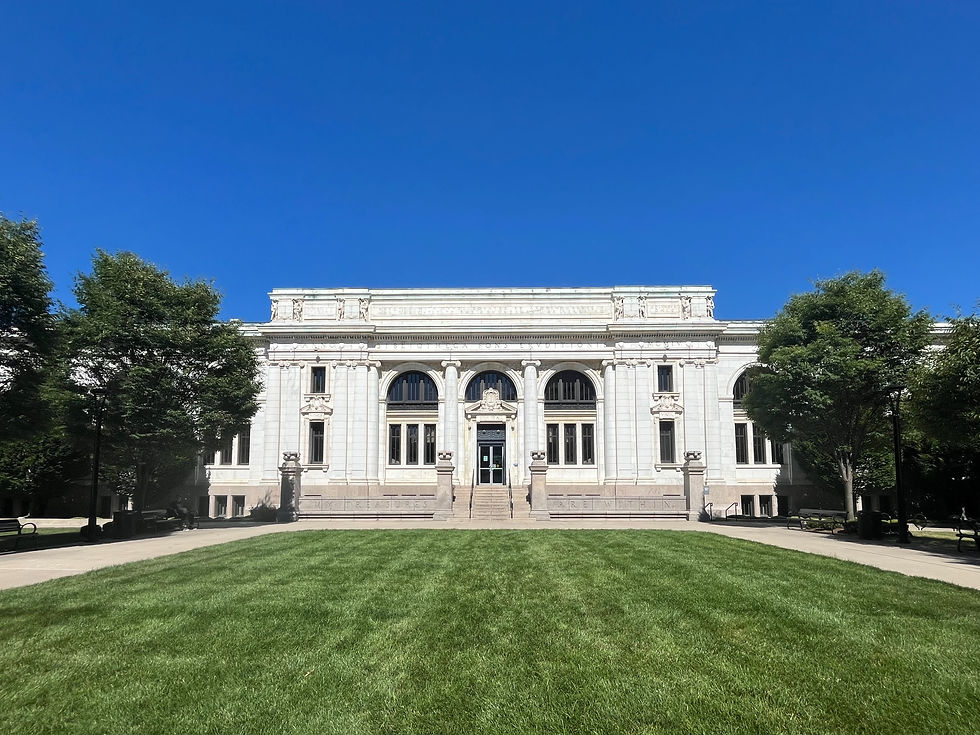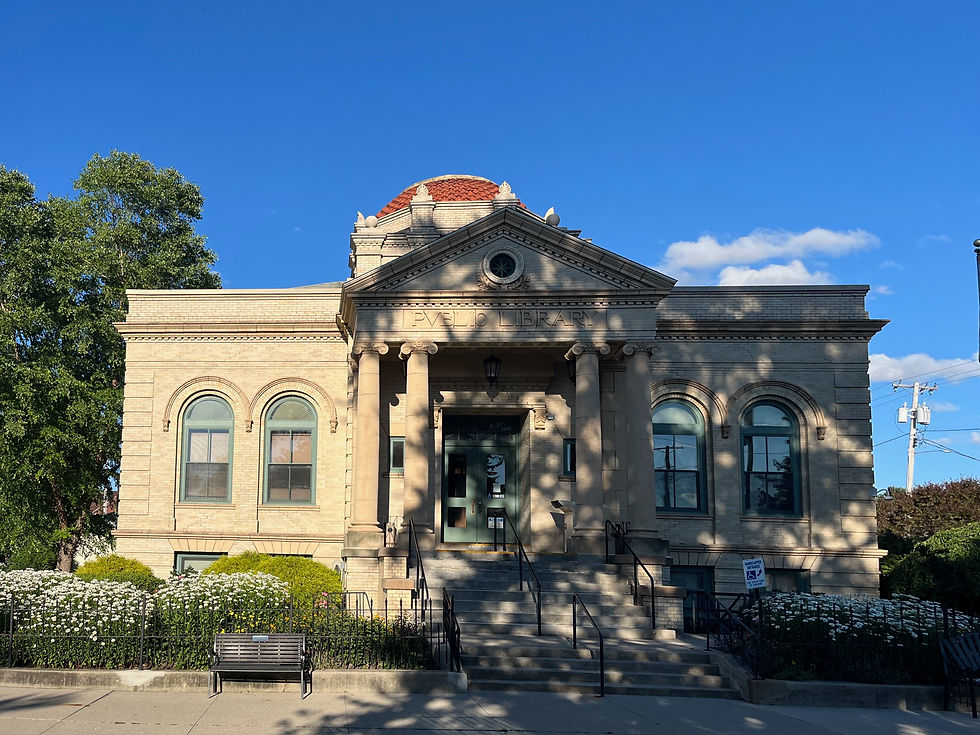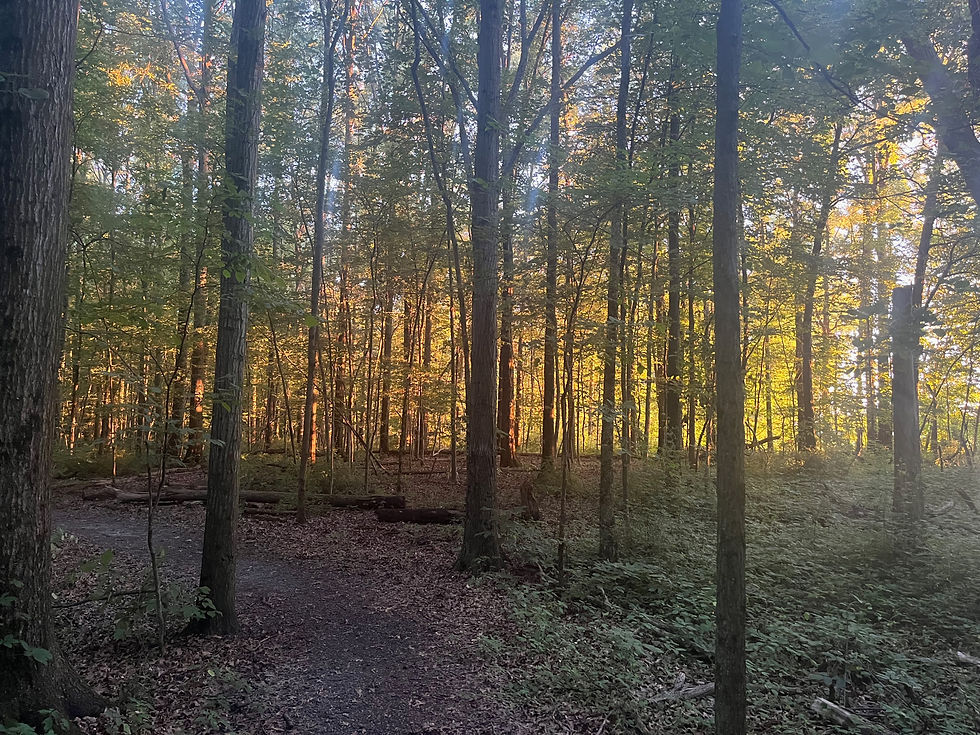Day 106, Sunday June 30, 2024: Cincinnati, Ohio to Galion, Ohio
- Mark Carl Rom
- Sep 9
- 7 min read
Updated: Sep 21
Carnegie libraries visited: Columbus, Mansfield, and Galion, Ohio
Days sober: 374

There’s nothing like a good round of applause to begin the day. That’s what the members of the 7 a.m. recovery meeting gave me. I don’t live for applause, although it’s nice to get it from time to time. It’s even better when it comes from those who know what it’s like to arise early, on a Sunday morning, in the effort to stay sober. Most meetings ask “Is there anyone at this meeting for the first time or just seeking a new way of life?” When I replied “I’m Mark, I’m an alcoholic, I’m just passing through, and this week I celebrated a year of continuous sobriety” the room erupted with cheers, right ons, keep coming backs, and welcomes. Nice.
Cincinnati is as far south as I will be until I return to Bethesda. I hope the weather respects this, and gives me the cool northern breezes I expect. Today, it did, as I angled 200 miles northeast across Ohio. I took the easy route, on Interstate 71, most of the day, a decision I’m now regretting. I could have just as easily taken Highways 22 and 23 to Columbus.
Had I driven that pleasant rural route, I could have visited another Carnegie library, in Wilmington, Ohio. Had I visited that library, I would have been more likely to discover that this was one of those libraries obtained largely through the efforts of local women. The town’s chapter of the Daughters of the American Revolution organized the Wilmington Library Association in 1899, hired a librarian – Miss Minnie Faren – and persuaded the town council to levy a tax to support their project.
Mrs. C.W. Swain, a member of the Association, used her husband’s law office stationery, to make the first pitch to Carnegie on January 9, 1901. Mrs. Swain asked Carnegie for $10,000. Bertram sent her an application form sometime in the coming months. On February 3, 1902 Swain wrote Bertram, eager to hear from him as it had been “more than two weeks” since she submitted the application. The very next week she wrote to him again, thanking Carnegie for awarding Wilmington a grant. She followed this with another letter on February 24 asking Bertram to give her the authority to choose the site “not for my own interest” but for “the best interests of the town.” Her husband C.W. followed up on February 25th, noting that “a controversy has arisen as to the location of this building” and that “unless someone is clothed with absolute authority (double underlined in the original) to designate the site your generosity will prove of no avail.” C.W. requested that Bertram add a stipulation to the offer “that said building be located on the site selected or to be selected by Mrs. C.W. Swain.” Bertram wasn’t going to have anything to do with this request. If he responded at all, his response is not included in the archives. Then again, it’s hard to archive eye rolling.

Columbus, Ohio, is one of six towns with that name to receive a Carnegie library. (The others were in Georgia, Indiana, Kansas, Nebraska, and Wisconsin.) The Ohio gift was unusual in size (initially, $150,000 and, ultimately, $200,000, as compared to the typical gift of $10-20,000) and purpose. Carnegie generally avoided funding large central libraries based on his views that libraries should be close to the people, and hence that branch libraries were preferable. This library is close to the “people’s house,” at least; the state capitol is less than a half mile away.

This is the kind of urban library that has it all. It’s located on the edge of Topiary Park, with its walking paths guiding me on this Sunday afternoon by shrubs trimmed to resemble characters from Georges Seurat’s most famous painting, “A Sunday Afternoon on the Island of La Grande Jatte.” The library has the indoor/outdoor “Java’s Carnegie’s Cafe – closed on Sundays, alas – the Carnegie (art) gallery, auditorium, gift shop, newspaper room, and all the other typical library amenities. A series of Lego villages were nestled against the bottom of the main stairwell. A cluster of large black somethings – the kind of modern art best described by the public at large as “what is that?” – hung from the ceiling. Best of all, the Columbus library was bustling with what looked to be a fair cross-section of the city’s residents. I enjoyed blending in with the locals on this hot final day of June.





North of Columbus, I visited two stately Carnegies that glowed in the late afternoon sun. “By any standards, the original Mansfield Carnegie Library on Third Street is a classic jewel of American civic architecture.imbuing our city with ancient cultural sophistication” wrote Timothy McKee in his online history of Richland County. The two modern additions which flank it retain the style while emphasizing the jewel that is in the middle. It does make me feel like buttoning up my shirt and tucking it in.

In 1887 Emily Huggins, Mary Mitchell, and Helen Weaver – three prominent Mansfielders – brought fifty other local women together to form the Mansfield Memorial Library Association. During the Association’s first year, it gathered over 800 books to form the basis of the library’s collection, and its work proceeded over the following years. By 1896, the Mansfield News acknowledged that
One point which has been touched upon but slightly, is the fact that Memorial Library was organized, incorporated, and is managed solely by women. Numerous attempts had been made at different times by the sons of Adam to organize and propagate an institution such as this in Mansfield, but it was not until women took the matter in charge that it was a success.
![Emily Huggins, Mary Mitchell, and Helen Weaver [source]](https://static.wixstatic.com/media/01e353_73c3cda5a594451fa57ff70e362c5352~mv2.png/v1/fill/w_980,h_638,al_c,q_90,usm_0.66_1.00_0.01,enc_avif,quality_auto/01e353_73c3cda5a594451fa57ff70e362c5352~mv2.png)
The women did not work alone. Joining forces with the civil war veterans in GAR (the “Grand Army of the Republic,” a national fraternal organization) the Library Association obtained public funding to build a Memorial Hall and Library (which also contained an opera house, meeting hall, and housing) that opened in 1988. Continued cohabitation with the veterans in a single building was a challenge (the library had only two rooms) yet it continued to grow in size and circulation.
Miss Martha Mercer, the library’s director, grew increasingly frustrated with overcrowding and “unruly Veterans” (according to McKee) and so approached Carnegie in 1903. It seems that, initially, she did this on the downlow: “For obvious reasons, it seemed best to keep the matter of a new library building quiet…” [NB: The reasons did not seem at all obvious to me, although it appears that Mercer had not received any official permission to write Carnegie.] Once an official request had been made and granted, Mercer could hardly contain her appreciation: “I should like Mr. Carnegie to know what it means to a tired and somewhat discouraged librarian to have such a prospect [the grant] as this…It was such a feeling of joy and pride that I made the very surprising announcement to the Board of Trustees…”
Joy and pride soon melted into frustrations and recriminations. Secretary Bertram was not amused to learn that Mansfield already had a $65,000 library, and so Mercer responded at great length that she was “deeply pained annoyed” that such a "misrepresentation" had been conveyed, and that the Memorial Hall and Library was mainly Hall and not Library. Helen Weaver – one of the founders of the Library Association – leaped in to defend Mercer and, really, it’s a bit difficult for me to figure out exactly what’s going on given the flurry of difficult to read letters. An exasperated Bertram ultimately responds that “Mr. Carnegie finds it impossible to enter into local controversies or differences” and that, at any rate, he deals only with public (elected) officials and not with individuals acting in their private capacities. Things got a bit ugly but, unless one really wants to spend time digging through the archives, the hard feelings that existed are not remembered, while the library – greatly expanded in the 1950s and again in the 1980s – lives on.

In the presidential debate that I had quickly turned off, Trump asserted that undocumented migrants were taking “Black Jobs.” This led to a million memes of those working in such “Black Jobs” as radiologists, accountants, cyber security, and so forth. I responded by starting to listen to a book by a “Black Author," Percival Everett, a Distinguished Professor of English at the University of Southern California. Everett, who calls himself “pathologically ironic” has written in numerous genres. The book I chose, Erasure, is a satiric account of the writer Monk whose novels don’t sell because his books, a publisher says, are not “Black enough.” (Monk’s brother, by the way, is a plastic surgeon and his sister is a doctor in a women’s health clinic.) Deeply offended by another “Black author” with a best-selling novel based on the most extreme racial stereotypes, Monk responds with the novella My Pafology (later, renamed Fuck) which in turn becomes a smash hit. The movie American Fiction, based on the book, is scored a 93 by the critics on RottenTomatoes. Now, I have to consider whether I should watch the movie before I finish the book.
Tonight, iOverlander recommends the Heckert Nature Preserve, five miles outside Galion. Review: “Flat asphalt parking lot for a small nature preserve not far off the highway. Two latrine toilets and an old picnic table. Peaceful night.” The lot was empty when I arrived about an hour before sunset. The preserve had a couple of walking paths, so I strolled into the woods, wary of ticks. Before I turned in for the night, a white panel van pulled in and quickly turned off its lights. A moment of concern: it’s getting late, I’m alone, we’re out in the country, and an unmarked van just arrived. Wait a minute, Mark: what are the chances that anyone wishing to do harm to another human would seek out a nature preserve at 11 o’clock on a Sunday night?

My consideration of whether or not to watch American Fiction was brief. I watched it. I’m only halfway through the book, so I can’t compare their endings. It won’t be the kind of conclusion that the movie The Natural had, in which Bernard Malamud’s despairing final scene is given a happy ever after Hollywood gloss: American Fiction ends with a bullet-riddled body. Two differences between Erasure and American Fiction illustrate the difference between American fiction (the genre, not the movie) and American film. (Mild spoiler alert.) In the book, Monk’s sister Lisa is assassinated by an anti-abortion zealot; in the movie, she dies from a heart attack. An attempt not to offend the pro-life crowd, or what? Erasure also includes an extended reading of My Pafology which doubles – triples – down on over-the-top parodies of blaxploitation tropes. (Sample conversation: “Fuck you.” “No, fuck you.” “Fuck you.” “Fuck you.” “No, fuuuck you.” “Fuck youuuuuu.”) The movie cuts out My Pafology almost completely, and the segment included is decidedly under-the-top. American Fiction does include, um, liberal use of the N word, and I’m not quite sure what to think about that.






Comments